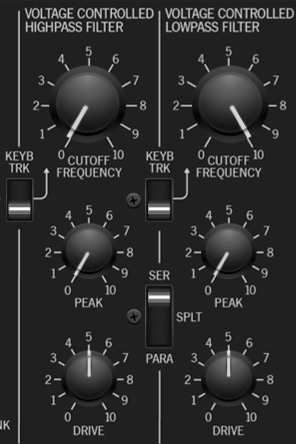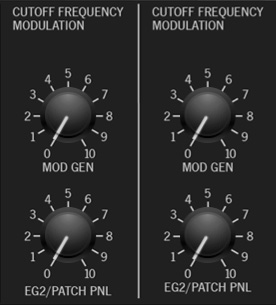
PS-20's filters super accurately recreate the MS-20's signature raunchy distorted sound. As we've mentioned, their penchant for honky, screaming distortion wasn't so much an intentional "feature," so much as it was a byproduct of its simple, thrifty design ethic. We carefully A/B'd PS-20's filters with the coveted "version 35" filter of the original instrument, and we think you'll be delighted with its authenticity.
If you're not familiar with how filters work, a lowpass filter allows frequencies below the cutoff frequency setting to pass through, but blocks frequencies above the cutoff frequency. Highpass is the opposite of lowpass mode: high-frequency content remains, but low frequencies are removed as the cutoff frequency increases. The original MS-20 has the filters configured in series; that is, the signal goes through the highpass filter first, then through the lowpass filter. Combining these in series results in a bandpass filter - low and high frequencies are removed, while the middle frequencies pass through (i.e., a "band" of frequencies). Unlike the original instrument, we've included a Series/Split/Parallel mode switch that adds two extra filters configurations for additional sounds, because we're cool that way.
Highpass and Low Filter Main Controls
HP Cutoff Freq- Sets the cutoff frequency of the highpass filter. All frequencies higher than the current setting are allowed to pass through the filter, while frequencies lower than the cutoff setting will be attenuated at a rate of 6 dB per/octave.
LP Cutoff Freq- All frequencies lower than the current setting are allowed to pass through the filter, while frequencies higher than the cutoff setting will be attenuated at a rate of 12 dB per/octave.
Peak (resonance)- Emphasizes sound energy at and around the cutoff frequency by adding feedback from the filter’s output back to its input. As the peak is increased, any modulations or knob twisting of the cutoff frequency becomes more pronounced and can create the classic “vowel-sound” this filter is known for. When turned up past seven or so, the filter begins to feed back enough to self-oscillate, sometimes like mad, so take extra precautions against speaker implosion, bleeding eardrums, and cat torture. On the other side of the cutoff frequency spectrum, PS-20's filters can create some major sub-rattling bass, just the thing if you're like Tigra and Bunny, and you like the-boom.
Drive- The Drive knobs allow control over filter distortion level. We recommend experimenting with them as they're really useful. At low settings, the filters clean up and sound decidedly un-MS-20ish, and of course at high settings, things get crazy. If you're using filter resonance to play musical notes (and you should), you'll want to crank the Drive up higher, particularly in combination with the Keyb Track switches.
Filter Drive knobs vs. Distortion effect
It's important to remember that PS-20 is inherently a polyphonic instrument. This means it has an independent highpass and lowpass filter for every voice (dependent upon the current Max Voices setting). As a result, the filters won't distort "against" one another. Conversely, the Distortion effect is a single distortion generator, so any time multiple chord notes are played through it, they'll be distorted as one entity. A good analogy would be to imagine the Distortion effect as if plugging an electric guitar into a single fuzz box and amplifier, and playing chords, whereas the filter Drive knobs would be equivalent to plugging each string of an electric guitar into its own independent fuzz box and amplifier - each note string (note) would cleanly distort with no interaction with the other strings (for a couple of minutes anyway, then the neighbors would call the cops on the crazy jerk playing six amplifiers at once).
Keyb Trk- These internally patch the keyboard CV to positively modulate the cutoff frequency. This means that the cutoff frequencies rises as higher notes are played on the keyboard, in order to keep tonality consistent. At high resonance settings, it also allows the ringing resonant frequency to play in tune across the keyboard, though results can vary depending on drive settings.
Series/Split/Parallel mode switch- This configures how the signal flows through the highpass and lowpass filters as follows:
Series- The signal from the mixer runs into the highpass filter, then to the lowpass filter, effectively creating a bandpass filter. This is how an original MS-20 operates.
Split- VCO 1 is routed through the highpass filter and VCO 2 is routed through the lowpass filter. In this setting, the mixer only acts as a volume control for each oscillator; VCO 1 and VCO 2 are mixed together after the filters. The noise generator signal is routed to both filters
Parallel- The mix of both of oscillators and noise is routed to the inputs of both filters, and their outputs are then mixed together.
It's worth clicking through all three positions when working on patches, as the results are often good. Differing cutoff and resonance settings in the three modes will create interesting filter responses, especially when the cutoff frequencies are modulated.
Cutoff Frequency Modulation Attenuator Controls

Sets the amount of modulation signals routed to the filters either via the hardwired internal MG triangle wave or from the patch panel Cutoff Freq mod input jacks when sources are plugged into them.
Mod Gen- Sets the amount of cutoff frequency mod from the mod generator (LFO) saw/triangle/ramp wave.
EG2/Patch Panel- Sets the amount of cutoff frequency mod from envelope generator 2 or a mod source plugged into the patch panel HP Filter and LP Filter Cutoff Freq mod input jacks.